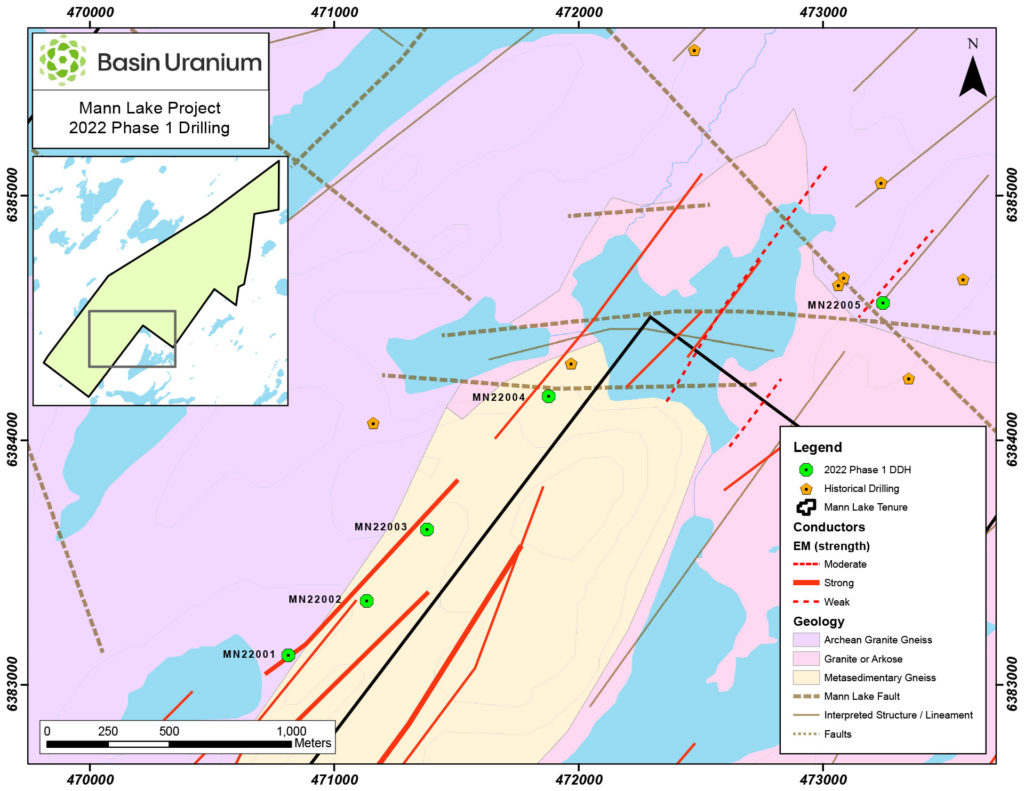Basin Uranium Announces Intersection of Significant Mineralization From Phase 1 Drilling at Mann Lake
VANCOUVER, B.C. CANADA, Sep. 07, 2022, BASIN URANIUM CORP. (CSE: NCLR) (OTC:BURCF) (FRA:6NP0) (“Basin Uranium” or the “Company”) is pleased to announce the intersection of significant uranium mineralization from the five-hole phase one drill program at its Mann Lake project located 25 km southwest of the McArthur River Mine and 15 km to the northeast along strike of Cameco’s Millennium uranium deposit.
“Our phase one drill program has confirmed the northeast trending conductor corridor (A3) as highly prospective for uranium mineralisation with the first significant intersection of uranium at Mann Lake. We are greatly encouraged as these new results substantially upgrade the potential of the underexplored southeastern half of the project.” commented Mike Blady, CEO of Basin Uranium. “We are looking forward to commencing phase two drilling in September and building off our successful phase one results.”
Phase One Drilling Highlights
- 323 ppm U3O8 over 0.5 meters, intersected 30 metres below the unconformity within a broader 7.2-metre interval of anomalous uranium and graphite mineralization in hole MN22002. Additionally, 46 ppm U3O8 over 0.5 meters intersected 8 metres below the unconformity and immediately beneath a strongly sericite bleached shear zone in hole MN22004.
- Significant boron (B) mineralization, which serves as a pathfinder element for uranium deposits, with over 1,000 ppm B encountered at the unconformity in hole MN22005, 525 ppm B encountered at the unconformity in hole MN22001 and 319 ppm B in dravite (boron-rich clay) blow the unconformity in hole MN22003.
- Significant rare earth elements (REE’s), including a highlight value of 5,028 ppm over 0.5 meters within a broader 50-metre interval of anomalous mineralization starting 20 metres below the unconformity in hole MN22003.
- Statistical analysis demonstrates correlation between anomalous concentrations of pathfinder elements (B, Co, Cu, Ni, and Pb) associated with the anomalous uranium mineralization. Pathfinder elements are widely regarded as guides to the discovery of unconformity-style uranium deposits and provide further evidence of the presence of fluid movement potentially related to a uranium mineralizing system.
A phase two drill program at Mann Lake is planned to commence shortly to follow-up on the encouraging results from phase one. It will also incorporate targets generated from the recently completed geophysical surveys on the property which include gravity and airborne mobile magnetotellurics (mobile MT). The results of these surveys are currently being analyzed and incorporated into historic geophysical surveys with results anticipated to be released in the near-term.
Phase One Drill Program Summary
The Phase 1 program was comprised of 3,503 metres of diamond drilling over five holes. Four drill holes (MN22001 – MN22004) over a strike length of 1,500 metres targeted the interpreted basement conductor from the 2014 MT resistivity survey, and a magnetic low (interpreted metasediment basement) within a gravity low anomaly (interpreted as a basement fault structure). One hole (MN22005) was drilled to test the intersection of a NE-trending structure parallel to MN06-005 which returned over 1,000 ppm boron at the unconformity, and a cross cutting E-W trending structure on strike to MN06-002 where hematite paleo weathering occurred at the unconformity.
Hole MN22001
Was drilled to test an interpreted basement conductor corresponding with ground UTEM conductor (A3), a mag low interpreted to be a metasediment basement host and a gravity low interpreted as a basement fault structure.
This hole was successful in crossing the unconformity and intersecting weakly anomalous radioactive values. It also intersected graphite mineralization along fracture planes and foliation, indicating the potential for nearby uranium mineralization.
Hole MN22002
Was designed to test the same conductor and geophysical setting as hole MN22001, collared 400 meters to the N-NE. It was successful, crossing the unconformity and entering basement metasediments (mostly psammite) as well as locating anomalous radioactive values with the handheld scintillometer and downhole probe. Monazite and allanite mineralization at the anomaly was also observed. Graphite mineralization was also noted in basement psammites along foliations and within some fractures. Notably, this hole returned 323 ppm U3O8 from 660.05 to 660.55 meters approximately 30 meters below the unconformity within a larger 7.2-meter interval of anomalous uranium radioactivity which is host to graphite mineralization.
Hole MN22003
Was a step-out of 350 meters to the N-NE of MN22002 and was designed to test the same conductor and geophysical setting. Blood-red hematite paleoweathering at the unconformity and silica mottling have overprinted the texture of the psammite directly below the unconformity. Dravite-clay alteration can be found within fractures throughout the paleoweathered section and decreasing in prevalence with depth.
This hole was successful in crossing the unconformity and intersecting radioactively anomalous intervals with allanite mineralization. Intervals within the basement rocks were found to contain graphite and dravite mineralization. Significant rare earth elements (REE’s) of 5,028 ppm over 0.5 meters from 681.22 meters downhole were intersected within a broader 50 metre zone of anomalous REE mineralization starting 20 metres below the unconformity.
Hole MN22004
Was a 150-meter step-out along the conductor and strike of MN06-003A which intersected 12 meters of hematized paleoweathering up hole of the unconformity. An interpreted basement conductor, mag low and gravity low were present.
While the hole did not intersect any lithology resembling the target Wollaston Group metasediments. The intersection of minor monazite mineralization, 46 ppm U3O8, over 0.33 meters starting from 615.22 meters downhole in close proximity to strong clay alteration, remains a potentially interesting indication of a uranium mineralization nearby.
Hole MN22005
This hole was designed to test the intersection of a NE-trending structure parallel to MN06-005 which returned over 1,000 ppm boron and 720cps at the unconformity, and a cross cutting E-W trending structure on strike to MN06-002 where 750cps and hematite paleoweathering occurred at the unconformity.
The hole was successful in intersecting a strongly hematite altered basement fault structure up hole and in close proximity to the unconformity. There was also a small interval of granitized strongly foliated metapelite intersected just below the unconformity, followed by granitic gneiss with intercalated pegmatites to the end of hole. Within the granite basement, clay dravite mineralization occurred, coating the surfaces of several low angle fractures between 652-663m.
Figure 1: Mann Lake Drill Plan

Table 1: Collar Locations
| Hole Number | Azimuth (Deg) | Dip (Deg) | Easting | Northing | Total Depth (m) | Depth to Unconformity (m) |
| MN22001 | 0 | -90 | 470812 | 6383121 | 731 | 650.65 |
| MN22002 | 0 | -90 | 471133 | 6383344 | 683 | 631.31 |
| MN22003 | 0 | -90 | 471379 | 6383635 | 713 | 630.95 |
| MN22004 | 0 | -90 | 471878 | 6384180 | 704.65 | 607.76 |
| MN22005 | 0 | -90 | 473245 | 6384561 | 671.67 | 623.79 |
| Total Meterage (m) | 3503.32 |
QA/QC
Samples were sent for geochemical analysis with SRC Geoanalytical Laboratories, Saskatoon for the following analyses: ICP-MS1 (Sandstone) and ICP-MS2 (Basement) which includes both partial and total digestion methods as well as an additional Boron analysis. Over limit analysis were completed using U3O8 total digestion when U >1000ppm.
On receipt of final certificates of analysis, the QA/QC sample results were reviewed to ensure the order of samples were reported correctly, that the blanks ran clean, and that the results for each standard had minimal variance from its certified value. QA/QC for the Mann Lake drilling included certified reference material (“CRM’s”) and blanks that were inserted into each sample batch in order to verify the analytical from the lab.
Qualified Person:
R. Tim Henneberry, PGeo (B.C.), a technical advisor to the Company, is the Qualified Person as defined by National Instrument 43-101 who has reviewed and approved the technical data in this news release.
About Basin Uranium Corp.
Basin Uranium Corp. is a Canadian junior exploration company focused on mineral exploration and development in the green energy sector. The Company owns the Wray Mesa project in southeastern Utah which has seen significant historic uranium and vanadium exploration and is located adjacent to the fully- permitted and production ready La Sal project. The Company has an option to acquire a 75% interest in the Mann Lake uranium project, located in the Athabasca basin in Northern Saskatchewan, Canada and holds an option in the CHG gold exploration project located approximately 15 kilometers northwest of the town of Clinton in south-central British Columbia.
For further information, please visit https://basinuranium.ca or email [email protected].
On Behalf of the Board of Directors
Mike Blady
Chief Executive Officer
[email protected]
Neither the Canadian Securities Exchange nor its regulation services provider accepts responsibility for the adequacy or accuracy of this news release.
FORWARD-LOOKING STATEMENTS:
Cautionary Note Regarding Forward-Looking Statements: This news release includes certain statements and information that may constitute forward-looking information within the meaning of applicable Canadian securities laws. All statements in this news release, other than statements of historical facts, including statements regarding future estimates, plans, objectives, timing, assumptions or expectations of future performance are forward-looking statements and contain forward-looking information. Generally, forward-looking statements and information can be identified by the use of forward-looking terminology such as “intends” or “anticipates”, or variations of such words and phrases or statements that certain actions, events or results “may”, “could”, “should”, “would” or “occur”. Forward-looking statements are based on certain material assumptions and analysis made by the Company and the opinions and estimates of management as of the date of this news release. These forward-looking statements are subject to known and unknown risks, uncertainties and other factors that may cause the actual results, level of activity, performance or achievements of the Company to be materially different from those expressed or implied by such forward-looking statements or forward-looking information. Important factors that may cause actual results to vary include, without limitation, uncertainties affecting the expected use of proceeds. Although management of the Company has attempted to identify important factors that could cause actual results to differ materially from those contained in forward-looking statements or forward-looking information, there may be other factors that cause results not to be as anticipated, estimated or intended. There can be no assurance that such statements will prove to be accurate, as actual results and future events could differ materially from those anticipated in such statements. Accordingly, readers should not place undue reliance on forward-looking statements and forward-looking information. Readers are cautioned that reliance on such information may not be appropriate for other purposes. The Company does not undertake to update any forward-looking statement, forward-looking information or financial out-look that are incorporated by reference herein, except in accordance with applicable securities laws.


